
Security News
RubyGems.org Adds New Maintainer Role
RubyGems.org has added a new "maintainer" role that allows for publishing new versions of gems. This new permission type is aimed at improving security for gem owners and the service overall.
A Javascript finite state machine (FSM) with a terse DSL and a simple API. Most FSMs are one-liners. Fast, easy, powerful, well tested, typed with TypeScript, and visualizations. MIT License.
Easy. Small. Fast. TS, es6, es5. Node, Browser. 100% coverage. Property tests. Fuzz tests. Language tests for a dozen languages and emoji. Easy to share online. Easy to embed.
Readable, useful state machines as one-liner strings.
4,923 tests run 5,814 times. 4,914 specs with 100.0% coverage, 9 fuzz tests with 13.1% coverage. With 2,834 lines, that's about 1.7 tests per line, or {{line_run_ratio}} generated tests per line.
Meet your new state machine library.
Discord community - Documentation - Issue tracker - CI build history
Wouldn't it be nice if your TypeScript and Javascript state machines were simple and readable one-liners?
import { sm } from 'jssm';
const TrafficLight = sm`Red -> Green -> Yellow -> Red;`;
Wouldn't it be great if they were easy to work with?
const log = s => console.log(s);
log( TrafficLight.state() ); // 'Red'
Machine.transition('Green'); // true
log( TrafficLight.state() ); // 'Green'
What if the notation supported action names easily?
const TLWA = sm`Red 'next' -> Green 'next' -> Yellow 'next' -> Red;`; // TLWA = Traffic Light With Actions
log( TLWA.state() ); // 'Red'
TLWA.action('next'); // true
log( TLWA.state() ); // 'Green'
TLWA.action('next'); // true
log( TLWA.state() ); // 'Yellow'
TLWA.action('next'); // true
log( TLWA.state() ); // 'Red'
What if integration with the outside was straightforward?
const MTL = sm`Red 'next' -> Green 'next' -> Yellow 'next' -> Red;` // MTL = More Traffic Lights
.hook('Red', 'Green', () => log('GO GO GO') ) // node will jump the gun when you hit return, though
.hook_entry('Red', () => log('STOP') ); // so put it on one line in node
log( MTL.state() ); // 'Red'
MTL.action('next'); // true, console logs 'GO GO GO'
log( MTL.state() ); // 'Green'
MTL.action('next'); // true
log( MTL.state() ); // 'Yellow'
MTL.action('next'); // true, console logs 'STOP'
log( MTL.state() ); // 'Red'
What if the machine followed JS standards, and distinguished refusals as false from mistakes as thrown?
const ATL = sm`Red -> Green -> Yellow -> Red;`; // ATL = Another Traffic Light
log( ATL.state() ); // 'Red' - uses 1st state unless told otherwise
ATL.transition('Yellow'); // false (Yellow isn't allowed from Red)
ATL.transition('Blue'); // throws (Blue isn't a state at all)
What if there were easy convenience notations for lists, and for designating main-path => vs available path -> vs
only-when-forced ~> ?
const TrafficLightWithOff = sm`
Red => Green => Yellow => Red;
[Red Yellow Green] ~> Off -> Red;
`;
What if that were easy to render visually?
const TrafficLightWithOff = sm`
Red => Green => Yellow => Red;
[Red Yellow Green] ~> Off -> Red;
`;

What if that were easy to render visually, with styling, in PNG, JPEG, or SVG?
const TrafficLightWithOff = sm`
Red => Green => Yellow => Red;
[Red Yellow Green] ~> Off -> Red;
flow: left;
state Red : { background-color: pink; corners: rounded; };
state Yellow : { background-color: lightyellow; corners: rounded; };
state Green : { background-color: lightgreen; corners: rounded; };
state Off : {
background-color : steelblue;
text-color : white;
shape : octagon;
linestyle : dashed;
};
`;
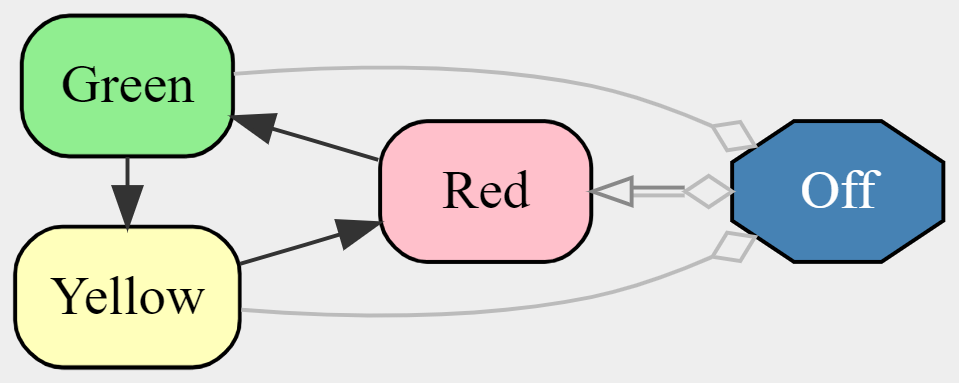
What if the machine was lighting fast, able to do tens of millions of transitions per second?
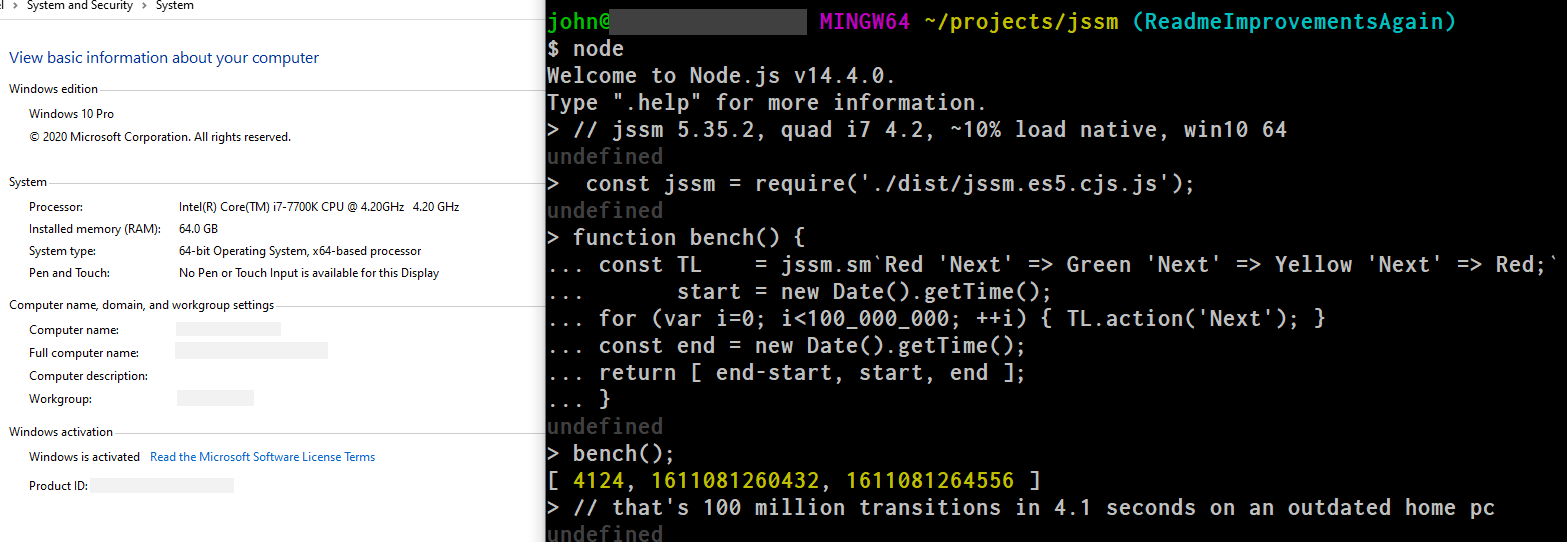
But, above all else:
What if it was easy?
Meet JSSM: the Javascript State Machine.
State machines can make your code cleaner, safer, and more trustworthy.
And, with the right language, state machines can be easy and fun.
JSSM is a Javascript state machine implementing Finite State Language, with a terse DSL and a simple API. 100% test coverage; typed with Flowtype. MIT licensed.
The NPM package includes pure es6, a cjs es5 bundle, and .d.ts typings. The repository includes the original typescript, the bundle, the es6, documentation, tests, tutorials, and so on.
Visualize with jssm-viz, or at the command line with jssm-viz-cli.
Language test cases for Belorussian, English, German, Hebrew, Italian, Russian, Spanish, Ukrainian, and Emoji. Please help to make sure that your language is well handled!
Specify finite state machines with a brief syntax. Run them; they're fast. Make mistakes; they're strict. Derive charts. Save and load states, and histories. Make machine factories to churn out dozens or thousands of instances. Impress friends and loved ones. Cure corns and callouses.
Red 'Proceed' -> Green 'Proceed' -> Yellow 'Proceed' -> Red;
This will produce the following FSM (graphed with jssm-viz):

You'll build an executable state machine.
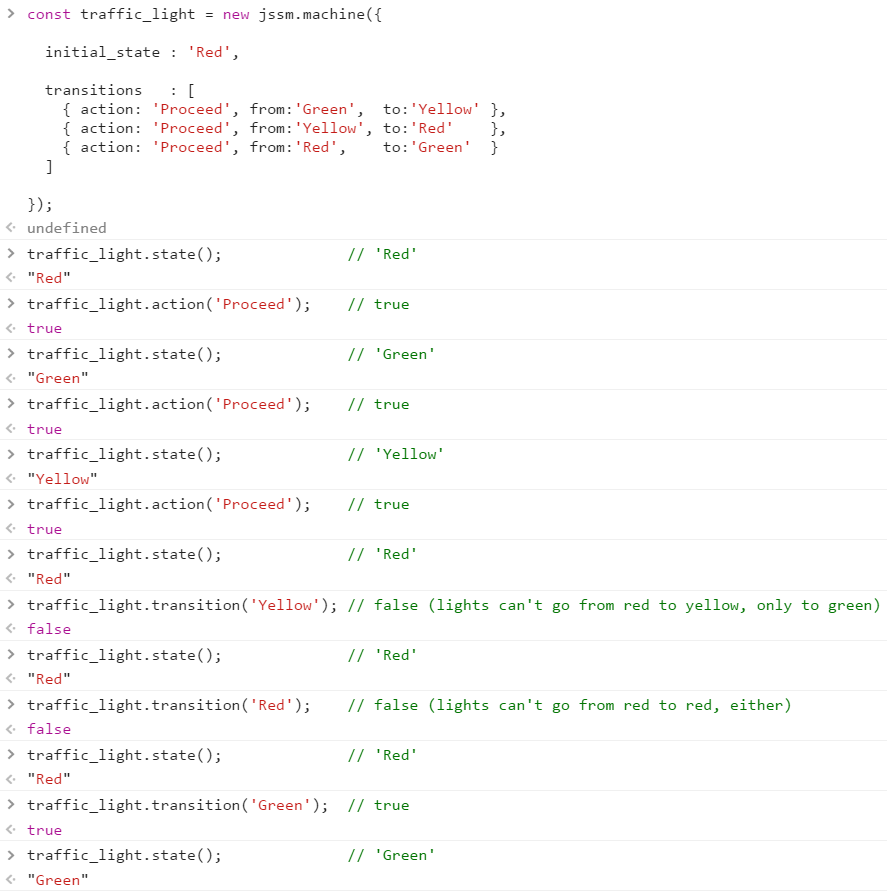
As usual, a valid question.
State machines are a method of making your software better able to prevent illegal states. Similar to type systems, SQL constraints, and linters, state machines are a way to teach the software to catch mistakes in ways you define, to help lead to better software.
The major mechanism of a state machine is to define states, the transitions between them, and sometimes associated
data and other niceties. The minor mechanism of state machines is to attach actions to the transitions, such that
the state machine can partially run itself.

So, to look at the same traffic light as above, you'll notice some things.
Green to switch to Yellow, but not to RedBlueGreen, to be told to Proceed means to go to Yellow, but
when in Yellow, it means to go to Red insteadAlong with other common sense things, a good state machine implementation can help eliminate large classes of error in software. State machines are often applied when the stakes on having things correct are high.
Brevity.
High quality testing. JSSM has 100% coverage, and has partial stochastic test coverage.
Feature parity, especially around the DSL and data control.
Data integrity. JSSM allows a much stricter form of state machine than is common, with a relatively low performance and storage overhead. It also offers an extremely terse domain specific language (though it does not require said DSL) to produce state machines in otherwise comparatively tiny and easily read code.
A state machine in
JSSMis defined in one of two ways: through the DSL, or through a datastructure.
So yeah, let's start by getting some terminology out of the way, and then we can go right back to that impenetrable sentence, so that it'll make sense.
Finite state machines have been around forever, are used by everyone, and are hugely important. As a result, the terminology is a mess, is in conflict, and is very poorly chosen, in accordince with everything-is-horrible law.
This section describes the terminology as used by this library. The author has done his best to choose a terminology that matches common use and will be familiar to most. Conflicts are explained in the following section, to keep this simple.
For this quick overview, we'll define six basic concepts:
Finite state machinesMachinesStatesCurrent stateTransitionsActionsThere's other stuff, of course, but these five are enough to wrap your head around finite state machines.
This is a trivial traffic light FSM, with three states, three transitions, and one action:
Red 'Proceed' -> Green 'Proceed' -> Yellow 'Proceed' -> Red;

Let's review its pieces.
finite state machines
finite state machine (or FSM) is a collection of states, and rules about how you can transition between
the states.FSM."FSM."states
FSMs always have at least one state, and nearly always many statesstates are Red, Yellow, and GreenFSM will only ever be one of those colors - not, say, Bluemachines
FSM are referred to as a machinemachines of the standard three color light FSM."current state
machine has a current state, though an FSM does not
FSMs do not have a current state, only specific machinesmachine will always have exactly one state - never multiple, never nonetransitions
FSMs nearly always have transitionsstate may be reached from another state
FSMstransitions are
machine whose current state is Green may switch to Yellow, because there is an appropriate transitionmachine whose current state is Green may not switch to Red, or to Green anew, because there is no
such transition
machine in Yellow which is told to transition to Green (which isn't legal) will know to refuseFSMs an effective tool for error preventionactions
FSMs have actions, which represent events from the outside world.action Proceed is available from all three colorsFSMs like the light to self-manage.machine in Yellow which is told to take the action Proceed will
know on its own to switch its current state to Red.FSMs an effective tool for complexity reductionThose six ideas in hand - FSMs, states, machines, current state, transitions, and actions - and you're ready
to move forwards.
One other quick definition - a DSL, or domain specific language, is when someone makes a language and embeds it into
a different language, for the purpose of attacking a specific job. When React uses a precompiler to embed stuff that
looks like HTML in Javascript, that's a DSL.
This library implements a simple language for defining finite state machines inside of strings. For example, this
DSL defines that 'a -> b;' actually means "create two states, create a transition between them, assign the first as
the initial state", et cetera. That micro-language is the DSL that we'll be referring to a lot, coming up. This
DSL's parser's original name was jssm-dot, because it's a descendant-in-spirit of an older flowcharting language
DOT, from graphviz, which is also used to make the
visualizations in jssm-viz by way of viz-js.
Enough history lesson. On with the tooling.
So let's put together a trivial four-state traffic light: the three colors, plus Off. This will give us an opportunity to go over the basic facilities in the language.
At any time, you can take the code and put it into the graph explorer for an opportunity to mess with the code as you see fit.
Our light will start in the Off state, with the ability to switch to the Red state.
Since that's a normal, not-notable thing, we'll just make it a regular -> legal transition.
Off -> Red;
We will give that transition an action, and call it TurnOn.
Off 'TurnOn' -> Red;
So far, our machine is simple:

The main path of a traffic light is cycling from Green to Yellow, then to Red, then back again. Because
this is the main path, we'll mark these steps => main transitions.
Off 'TurnOn' -> Red => Green => Yellow => Red;
We will give those all the same action name, Proceed, indicating "next color" without needing to know what we're currently on.
Off 'TurnOn' -> Red 'Proceed' => Green 'Proceed' => Yellow 'Proceed' => Red;
Machine's still pretty simple:
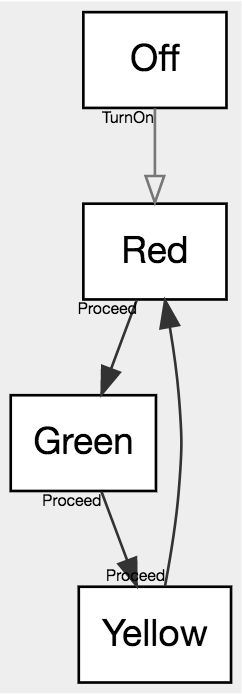
We'd also like to be able to turn this light back off. Because that's expected to be a rarity, we'll require that it
be a ~> forced transition.
We could write
Off 'TurnOn' -> Red 'Proceed' => Green 'Proceed' => Yellow 'Proceed' => Red;
Red ~> Off;
Yellow ~> Off;
Green ~> Off;
But that takes a lot of space even with this short list, so, instead we'll use the array notation
Off 'TurnOn' -> Red 'Proceed' => Green 'Proceed' => Yellow 'Proceed' => Red;
[Red Yellow Green] ~> Off;
And we'd like those all to have the action TurnOff, so
Off 'TurnOn' -> Red 'Proceed' => Green 'Proceed' => Yellow 'Proceed' => Red;
[Red Yellow Green] 'TurnOff' ~> Off;
Machine's still not too bad:
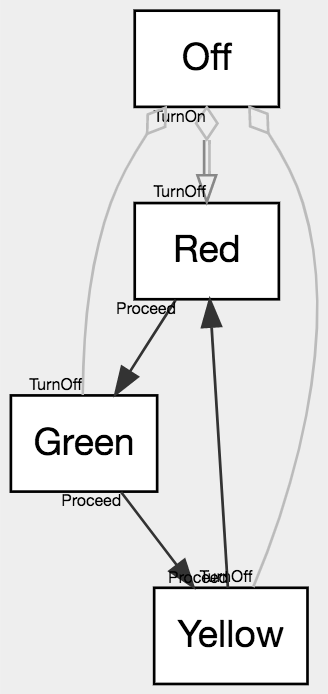
That's actually the bulk of the language. There are other little add-ons here and there, but, primarily you now know how to write a state machine.
Let's load it and use it! 😀
Let's make a state machine for ATMs. In the process, we will use a lot of core concepts of finite state machines
and of fsl, this library's DSL.
We're going to improve on this NCSU ATM diagram that I found:

Remember, at any time, you can take the code and put it into the graph explorer for an opportunity to mess with the code as you see fit.
We'll start with an empty machine.
EmptyWaiting 'Wait' -> EmptyWaiting;

We'll add the ability to physically eject the user's card and reset to the empty and waiting state. Right now it'll dangle around un-used at the top, but later it'll become useful.
This is expressed as the path EjectCardAndReset -> EmptyWaiting;
EmptyWaiting 'Wait' -> EmptyWaiting;
EjectCardAndReset -> EmptyWaiting;
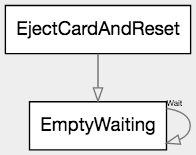
We'll add the ability to physically insert a card, next. You know, the, uh, thing ATMs are pretty much for.
To get this, add the path leg EmptyWaiting 'InsertCard' -> HasCardNoAuth;
EmptyWaiting 'Wait' -> EmptyWaiting 'InsertCard' -> HasCardNoAuth;
EjectCardAndReset -> EmptyWaiting;
Notice that the new state, HasCardNoAuth, has been rendered red. This is because it is terminal - there is
no exit from this node currently. (EmptyAndWaiting did not render that way because it had a transition to itself.)
That will change as we go back to adding more nodes. terminal nodes are usually either mistakes or the last single
state of a given FSM.
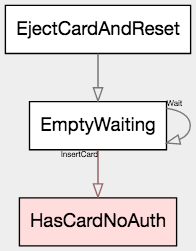
Next, we should have a cancel, because the ATM's 7 key is broken, and we need our card back. Cancel will exit to the main menu, and return our card credential.
To that end, we add the path HasCardNoAuth 'CancelAuthReturnCard' -> EjectCardAndReset;
EmptyWaiting 'Wait' -> EmptyWaiting 'InsertCard' -> HasCardNoAuth;
HasCardNoAuth 'CancelAuthReturnCard' -> EjectCardAndReset;
EjectCardAndReset -> EmptyWaiting;
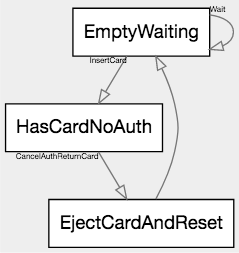
Next, let's give the ability to get the password ... wrong. 😂 Because we all know that one ATM that only has the wrong-PIN path, so, apparently that's a product to someone.
When they get the PIN wrong, they're prompted to try again (or to cancel.)
We'll add the path HasCardNoAuth 'WrongPIN' -> HasCardNoAuth;
EmptyWaiting 'Wait' -> EmptyWaiting 'InsertCard' -> HasCardNoAuth;
HasCardNoAuth 'CancelAuthReturnCard' -> EjectCardAndReset;
HasCardNoAuth 'WrongPIN' -> HasCardNoAuth;
EjectCardAndReset -> EmptyWaiting;
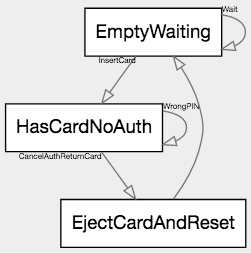
Next, let's give the ability to get the password right.
We'll add two paths. The first gets the password right: HasCardNoAuth 'RightPIN' -> MainMenu;
The second, from our new state MainMenu, gives people the ability to leave: MainMenu 'ExitReturnCard' -> EjectCardAndReset;
EmptyWaiting 'Wait' -> EmptyWaiting 'InsertCard' -> HasCardNoAuth;
HasCardNoAuth 'CancelAuthReturnCard' -> EjectCardAndReset;
HasCardNoAuth 'WrongPIN' -> HasCardNoAuth;
HasCardNoAuth 'RightPIN' -> MainMenu;
MainMenu 'ExitReturnCard' -> EjectCardAndReset;
EjectCardAndReset -> EmptyWaiting;

Hooray, now we're getting somewhere.
Let's add the ability to check your balance. First pick that from the main menu, then pick which account to see the balance of, then you're shown a screen with the information you requested; then go back to the main menu.
That's MainMenu 'CheckBalance' -> PickAccount -> DisplayBalance -> MainMenu;.
EmptyWaiting 'Wait' -> EmptyWaiting 'InsertCard' -> HasCardNoAuth;
HasCardNoAuth 'CancelAuthReturnCard' -> EjectCardAndReset;
HasCardNoAuth 'WrongPIN' -> HasCardNoAuth;
HasCardNoAuth 'RightPIN' -> MainMenu;
MainMenu 'ExitReturnCard' -> EjectCardAndReset;
MainMenu 'CheckBalance' -> PickAccount -> DisplayBalance -> MainMenu;
EjectCardAndReset -> EmptyWaiting;
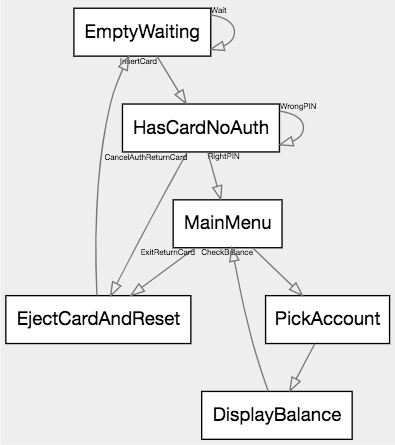
Let's add something difficult. Their state machine just proceeds assuming everything is okay.
To desposit money:
Writing this out in code is not only generally longer than the text form, but also error prone and hard to maintain.
... or there's the FSM DSL, which is usually as-brief-as the text, and frequently both briefer and more explicit.
MainMenu 'AcceptDeposit' -> TentativeAcceptMoney 'AcceptFail' -> RejectPhysicalMoney -> MainMenu;TentativeAcceptMoney 'AcceptSucceed' -> PickDepositAccount -> RequestValue 'TellBank' -> BankResponse;BankResponse 'BankNo' -> RejectPhysicalMoney;BankResponse 'BankYes' -> ConsumeMoney -> NotifyConsumed -> MainMenu;BankResponse 'BankAudit' -> BankAuditOffer 'HumanAcceptAudit' -> ConsumeMoney;BankAuditOffer 'HumanRejectAudit' -> RejectPhysicalMoney;Or, as a block,
MainMenu 'AcceptDeposit' -> TentativeAcceptMoney;
TentativeAcceptMoney 'AcceptFail' -> RejectPhysicalMoney -> MainMenu;
TentativeAcceptMoney 'AcceptSucceed' -> PickDepositAccount -> RequestValue 'TellBank' -> BankResponse;
BankResponse 'BankNo' -> RejectPhysicalMoney;
BankResponse 'BankYes' -> ConsumeMoney -> NotifyConsumed -> MainMenu;
BankResponse 'BankAudit' -> BankAuditOffer 'HumanAcceptAudit' -> ConsumeMoney;
BankAuditOffer 'HumanRejectAudit' -> RejectPhysicalMoney;
Which leaves us with the total code
EmptyWaiting 'Wait' -> EmptyWaiting 'InsertCard' -> HasCardNoAuth;
HasCardNoAuth 'CancelAuthReturnCard' -> EjectCardAndReset;
HasCardNoAuth 'WrongPIN' -> HasCardNoAuth;
HasCardNoAuth 'RightPIN' -> MainMenu;
MainMenu 'AcceptDeposit' -> TentativeAcceptMoney;
MainMenu 'ExitReturnCard' -> EjectCardAndReset;
MainMenu 'CheckBalance' -> PickCheckBalanceAccount -> DisplayBalance -> MainMenu;
TentativeAcceptMoney 'AcceptFail' -> RejectPhysicalMoney -> MainMenu;
TentativeAcceptMoney 'AcceptSucceed' -> PickDepositAccount -> RequestValue 'TellBank' -> BankResponse;
BankResponse 'BankNo' -> RejectPhysicalMoney;
BankResponse 'BankYes' -> ConsumeMoney -> NotifyConsumed -> MainMenu;
BankResponse 'BankAudit' -> BankAuditOffer 'HumanAcceptAudit' -> ConsumeMoney;
BankAuditOffer 'HumanRejectAudit' -> RejectPhysicalMoney;
EjectCardAndReset -> EmptyWaiting;
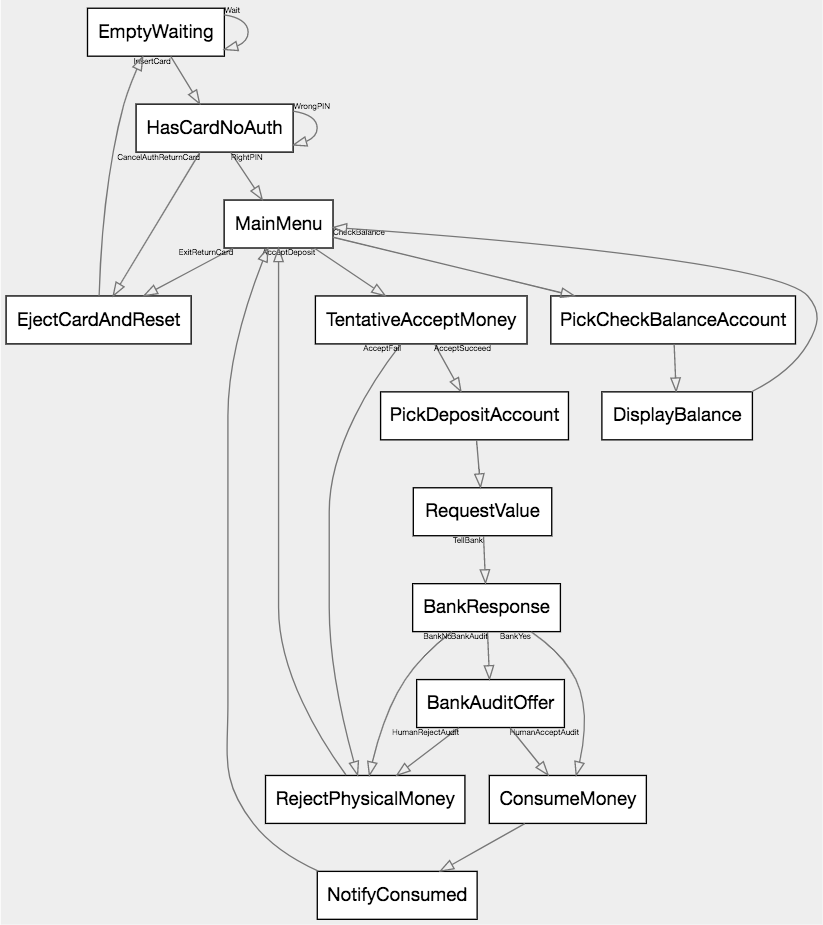
Let's also be able to take money from the machine. After this, we'll move on, since our example is pretty squarely made by now.
MainMenu -> PickWithdrawlAccount -> PickAmount -> AcctHasMoney? 'TooHighForAcct' -> PickWithdrawlAccount;AcctHasMoney? -> MachineHasMoney? 'MachineLowOnCash' -> PickAmount;MachineHasMoney? -> ConfirmWithdrawWithHuman 'MakeChanges' -> PickWithdrawlAmount;ConfirmWithdrawWithHuman 'PostWithdrawl' -> BankWithdrawlResponse;BankWithdrawlResponse 'WithdrawlFailure' -> WithdrawlFailureExplanation -> PickWithdrawlAccount;BankWithdrawlResponse 'WithdrawlSuccess' -> DispenseMoney -> MainMenu;Rule 1 canceller: PickWithdrawlAccount 'CancelWithdrawl' -> MainMenu;
Rule 2 canceller: PickWithdrawlAmount 'SwitchAccounts' -> PickWithdrawlAccount;
Or as a whole, we're adding
MainMenu -> PickWithdrawlAccount -> PickAmount -> AcctHasMoney? 'TooHighForAcct' -> PickWithdrawlAccount;
AcctHasMoney? -> MachineHasMoney? 'MachineLowOnCash' -> PickAmount;
MachineHasMoney? -> ConfirmWithdrawWithHuman 'MakeChanges' -> PickWithdrawlAmount;
ConfirmWithdrawWithHuman 'PostWithdrawl' -> BankWithdrawlResponse;
BankWithdrawlResponse 'WithdrawlFailure' -> WithdrawlFailureExplanation -> PickWithdrawlAccount;
BankWithdrawlResponse 'WithdrawlSuccess' -> DispenseMoney -> MainMenu;
PickWithdrawlAccount 'CancelWithdrawl' -> MainMenu;
PickWithdrawlAmount 'SwitchAccounts' -> PickWithdrawlAccount;
Which leaves us with
EmptyWaiting 'Wait' -> EmptyWaiting 'InsertCard' -> HasCardNoAuth;
HasCardNoAuth 'CancelAuthReturnCard' -> EjectCardAndReset;
HasCardNoAuth 'WrongPIN' -> HasCardNoAuth;
HasCardNoAuth 'RightPIN' -> MainMenu;
MainMenu 'AcceptDeposit' -> TentativeAcceptMoney;
MainMenu 'ExitReturnCard' -> EjectCardAndReset;
MainMenu 'CheckBalance' -> PickCheckBalanceAccount -> DisplayBalance -> MainMenu;
TentativeAcceptMoney 'AcceptFail' -> RejectPhysicalMoney -> MainMenu;
TentativeAcceptMoney 'AcceptSucceed' -> PickDepositAccount -> RequestValue 'TellBank' -> BankResponse;
BankResponse 'BankNo' -> RejectPhysicalMoney;
BankResponse 'BankYes' -> ConsumeMoney -> NotifyConsumed -> MainMenu;
BankResponse 'BankAudit' -> BankAuditOffer 'HumanAcceptAudit' -> ConsumeMoney;
BankAuditOffer 'HumanRejectAudit' -> RejectPhysicalMoney;
MainMenu -> PickWithdrawlAccount -> PickAmount -> AcctHasMoney? 'TooHighForAcct' -> PickWithdrawlAccount;
AcctHasMoney? -> MachineHasMoney? 'MachineLowOnCash' -> PickAmount;
MachineHasMoney? -> ConfirmWithdrawWithHuman 'MakeChanges' -> PickWithdrawlAmount;
ConfirmWithdrawWithHuman 'PostWithdrawl' -> BankWithdrawlResponse;
BankWithdrawlResponse 'WithdrawlFailure' -> WithdrawlFailureExplanation -> PickWithdrawlAccount;
BankWithdrawlResponse 'WithdrawlSuccess' -> DispenseMoney -> MainMenu;
PickWithdrawlAccount 'CancelWithdrawl' -> MainMenu;
PickWithdrawlAmount 'SwitchAccounts' -> PickWithdrawlAccount;
EjectCardAndReset -> EmptyWaiting;
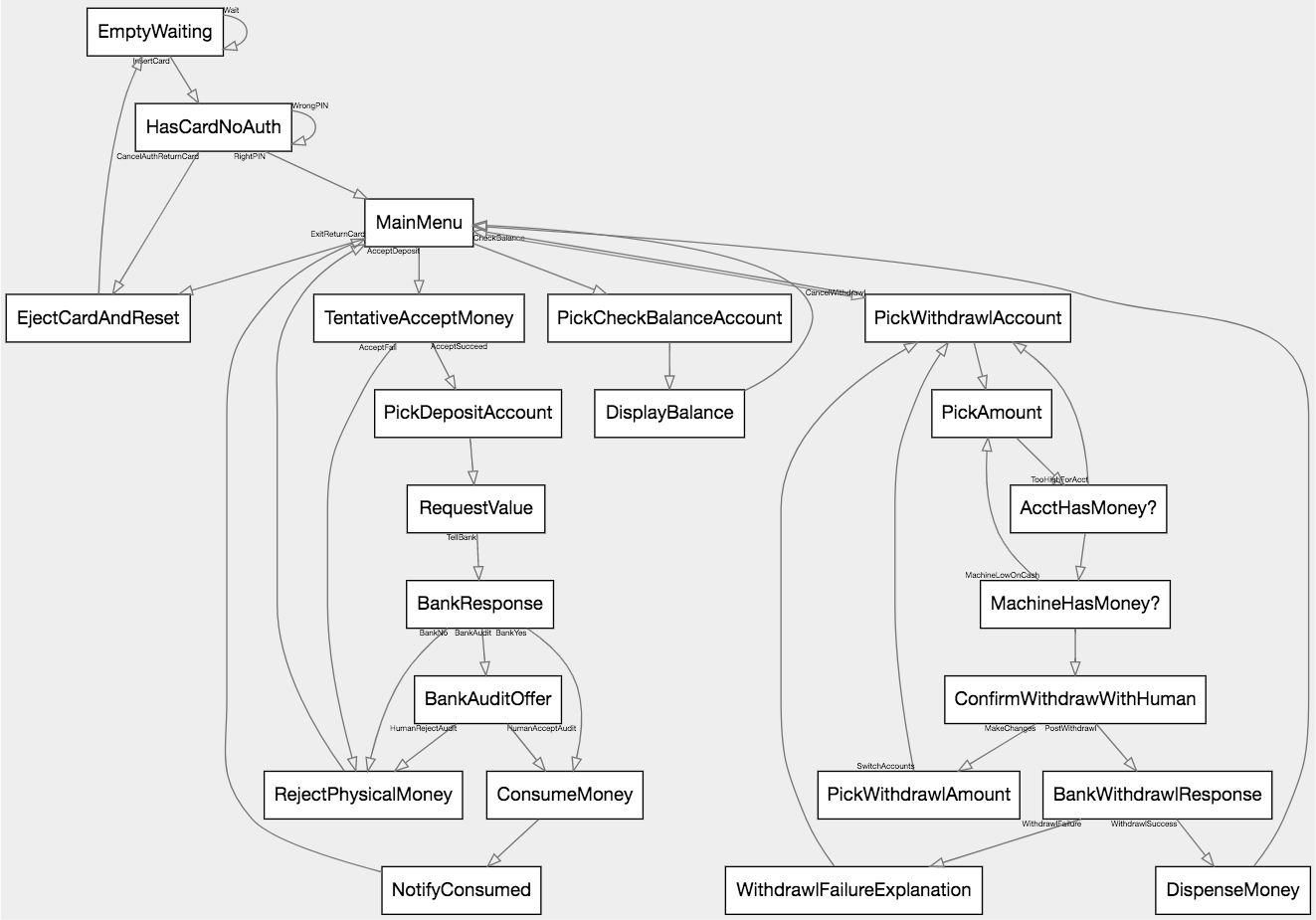
As you can see, building up even very complex state machines is actually relatively straightforward, in a short amount of time.
It's really quite simple.
.fslmachine_nameOnce done, your work should show up here.
There are a lot of state machine impls for JS, many quite a bit more mature than this one. Here are some options:
And some similar stuff:
JSSM and FSL have had a lot of help.
FSL machine, in Bengali.If I've overlooked you, please let me know.
If you'd like to help, it's straightforward.
Vat Raghavan has participated extensively in language discussion and implemented several features.
Forest Belton has provided guidance, bugfixes, parser and language commentary.
Jordan Harbrand suggested two interesting features and provided strong feedback on the initial tutorial draft.
The biggest thanks must go to Michael Morgan, who has debated significant sections of
the notation, invented several concepts and operators, helped with the parser, with system nomenclature, for having published
the first not-by-me FSL machine, for encouragement, and generally just for having been as interested as he has been.
FAQs
A Javascript finite state machine (FSM) with a terse DSL and a simple API. Most FSMs are one-liners. Fast, easy, powerful, well tested, typed with TypeScript, and visualizations. MIT License.
The npm package jssm receives a total of 1,010 weekly downloads. As such, jssm popularity was classified as popular.
We found that jssm demonstrated a healthy version release cadence and project activity because the last version was released less than a year ago. It has 0 open source maintainers collaborating on the project.
Did you know?

Socket for GitHub automatically highlights issues in each pull request and monitors the health of all your open source dependencies. Discover the contents of your packages and block harmful activity before you install or update your dependencies.

Security News
RubyGems.org has added a new "maintainer" role that allows for publishing new versions of gems. This new permission type is aimed at improving security for gem owners and the service overall.

Security News
Node.js will be enforcing stricter semver-major PR policies a month before major releases to enhance stability and ensure reliable release candidates.

Security News
Research
Socket's threat research team has detected five malicious npm packages targeting Roblox developers, deploying malware to steal credentials and personal data.